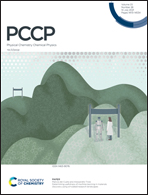From high quality packing to disordered nucleation or phase separation in donor/acceptor interfaces: ClAlPc-C60 on Au(111)†
Abstract
The dramatic consequences that the orientation adopted by the molecular dipoles, in diverse arrays of chloroaluminum phthalocyanine (ClAlPc) on Au(111), have on the ulterior adsorption and growth of C60 are explored by means of an all scanning probe microscopy approach. The unidirectional downwards organization of the molecular dipoles at the first layer reduces charge transfer from the metal to C60. Imbalance between attractive and repulsive interactions of the fullerenes are crucial for their ordered supramolecular aggregation. The effect at the basis of such self-assembling seems to be released by the all upwards dipole orientation adopted on the ClAlPc second layer. The low electronic corrugation of the bilayer results in a higher mobility of the fullerenes which for similar coverages diffuse large distances to reach uncovered first layer regions. Density functional theory calculations corroborate the experimental observations indicating the relevance of charge transfer, potential energy surface corrugation, C60 on-surface diffusion barriers and screening. The structure of the co-adsorbed C60 and ClAlPc layers strongly depends on the deposition sequence. Phase-separation, where each molecule adopts the single-component assembly, occurs if C60 is deposited first. The present results contribute to understanding the influence of the dipolar nature of molecular layers on the electronic and structure of donor/acceptor heterojunctions, which is crucial for device design via engineering the energy level alignment at organic–organic and organic–metal interfaces.



 Please wait while we load your content...
Please wait while we load your content...